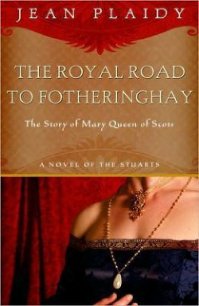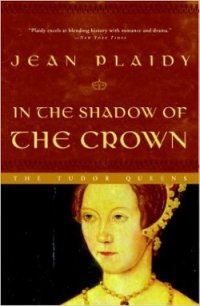The Captive Queen of Scots - Plaidy Jean (читать книги онлайн бесплатно без сокращение бесплатно txt) 📗
But she was not thinking of the Queen of Scots and her dilemma; what astonished her was to be confronted by such a disobedient husband.
She went on: “Do you think it was wise to suggest this move?”
“It was wise and humane,” answered the Earl firmly.
“The Queen will have a poor opinion of us if we continually present her with complaints.”
“The Queen knows us both well. She has long since formed her opinions of us.”
“She chose us for this task, and it is one well within our compass, if we are wise and do not allow ourselves to be duped by the wiles of one who, I understand, has but to give a man a smile to make him obey her.”
“She has not been very successful in making men obey her, poor lady.”
“Poor lady! Not so poor! She is waited on hand and foot. I am surprised, George, that you should have taken this step without consulting me.”
He shrugged his shoulders. “Well,” he said mildly, “it is done. What we have to do now is prepare to leave for Wingfield Manor.”
Bess was watching him covertly. She had thought he would always be obedient to her wishes as her three earlier husbands had been. It was disconcerting to find him asserting his independence.
What could it mean?
Was he a little enamored of the Queen of Scots? She must be watchful. Bess was a woman who demanded a husband’s affection and devotion as well as obedience. She would not allow it to be said that Shrewsbury ceased to be a devoted husband when the Queen of Scots came under his roof.
That woman might bewitch other men but, Bess was determined, never George Talbot, Earl of Shrewsbury.
VII
Wingfield
MARY WAS DELIGHTED TO ARRIVE at Wingfield Manor. She could not feel grateful enough to Shrewsbury for arranging the removal for, in comparison with Tutbury, Wingfield was charming. Situated as it was on a steep hill it commanded a beautiful view of the valley of Ashover and seemed to be shut in by hills.
The manor house had been built some hundred years before by Ralph, Lord Cromwell and, because he had been Treasurer of England, bags and purses had been carved in the stone over the gateway which led to the quadrangle. Having been built at that period when the comfort of castles was being questioned, and desirability of building palaces realized, this was an excellent example of what a hundred years before had been considered a new type of architecture.
The house was built around two square courts and as soon as Mary stepped into the spacious hall with its Gothic windows, one of a very unusual octagonal shape, her natural optimism took possession of her. Tutbury was left behind and she was telling herself that nothing so unfortunate as her stay in that noisome place would ever happen to her again. She should rejoice that that evil was behind her.
Countess Bess took her to the rooms which had been allotted to her.
“They are on the west side of the north court, Your Majesty,” she said, “and this is generally judged to be the most beautiful part of the building.”
Mary stood for a while looking out over the hills.
“It is undoubtedly beautiful,” she said. “A change from the marshlands of Tutbury. And how pleasant to have lost that appalling odor.”
The Countess gave her a quick, sudden laugh. “I am sure Your Majesty will be comfortable at Wingfield. Allow me to show you these stairs. They lead up to the Tower which will be part of your quarters.”
Mary mounted the spiral staircase to the top of the Tower, and from there she had a wider view of the countryside than that from the windows of her bedchamber.
She stood looking into the far distance.
One day, she thought, my friends will come riding here to rescue me.
She turned away and smiled at the Countess who had followed her to the Tower.
Yes, she could certainly rejoice that she had come to Wingfield Manor.
EVEN NOW THAT SHE was in more salubrious surroundings Mary needed time to recover from the harm which had been done to her during that journey through the snow from Bolton to Tutbury and her stay in the damp apartments of the latter. She was never free from twinges of pain in her limbs and sometimes when she attempted to rise from her bed she found it impossible to do so without assistance.
“Ah, Seton,” she would often say, “I left my youth behind me in Tutbury.”
She spent those first weeks in Wingfield writing letters and recuperating, promising herself that when the spring came, and she could go hunting or hawking in this beautiful countryside, she would feel young again.
The Countess seemed to soften at Wingfield and was solicitous of Mary’s comfort; she implied that she was in charge of the household and any request Mary wished to make should be made, not to the Earl, but to herself; and Mary quickly realized that as long as she accepted the Countess’s supremacy, Bess was ready to be her friend. Seton had said that she would be happier with the Countess as a friend rather than an enemy, with which statement Mary had agreed.
Spring was now on the way and, although its coming must remind Mary that she had been almost a year in England, she was pleased to see it.
One evening after supper Mary complained of sudden pains and as she rose from the table began to shiver. Her women, startled by her pallor, crowded about her, and she told them that she felt alarmingly sick and dizzy.
Seton, taking charge, hastily conducted her to her bedchamber and as Mary lay writhing on her bed a horrible suspicion came to Seton that her mistress had been poisoned.
She turned to Jane Kennedy and said: “Go at once to the Earl and Countess and tell them that I fear the Queen is grievously ill.”
Jane hurried to the Earl’s apartments and, finding him alone there, told him of Seton’s fears. The Earl went at once to Mary’s bedchamber and when he saw her he was deeply disturbed.
“Her Majesty’s apothecary is preparing a remedy for her,” said Seton. “But I think she may need greater skill than his.”
At that moment the Countess came into the apartment.
“What is wrong?” she demanded. Then she saw the Queen. “I shall send at once for Dr. Caldwell,” she said. “I do not like what I see.”
For once Seton was glad of the Countess’s methods when, in a very short time, the doctor for whom she had sent arrived in the Queen’s chamber.
He spent the night at her bedside and in the morning, much to the surprise of all those who had seen how ill she was and the nature of her illness, Mary still lived.
BESS TALKED in private with her husband.
“I do not like the look of this,” she said.
“Nor I.”
“I believe someone tried to poison her.”
The Earl nodded. Bess looked at him in silence for a few moments, then she said: “Do you think she has commanded this to be done?”
“Never!” The Earl was emphatic. “If the Queen of Scots were to die of poison, the first person to be suspected would be Elizabeth. She would not want that. If there are men and women in this country who would wish to set a Stuart on the English throne, there is nothing more likely to advance their cause than such a murder. The Queen of Scots would become a martyr while the Queen of England would be reckoned a monster. I am sure this has nothing to do with Elizabeth.”
“Then it is clearly one of Moray’s people.”
“And how can we say who? Scotsmen come and go. They declare themselves to be friends of Queen Mary, but depend upon it, there are spies among them. If she were to die . . . .”
His wife interrupted: “We should no longer enjoy Elizabeth’s favor. She would blame us for allowing poisoners to have access to her.”
“But how can we prevent that?”




